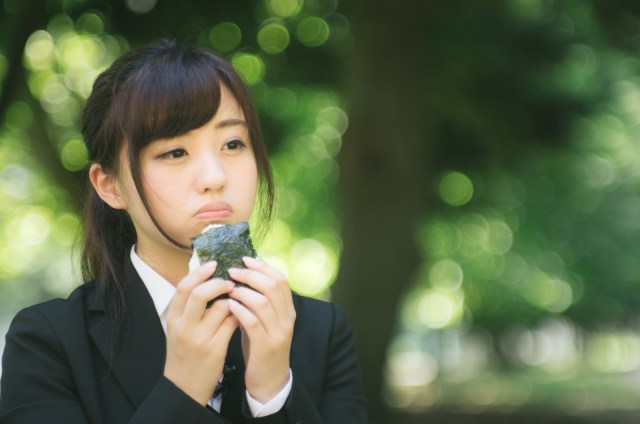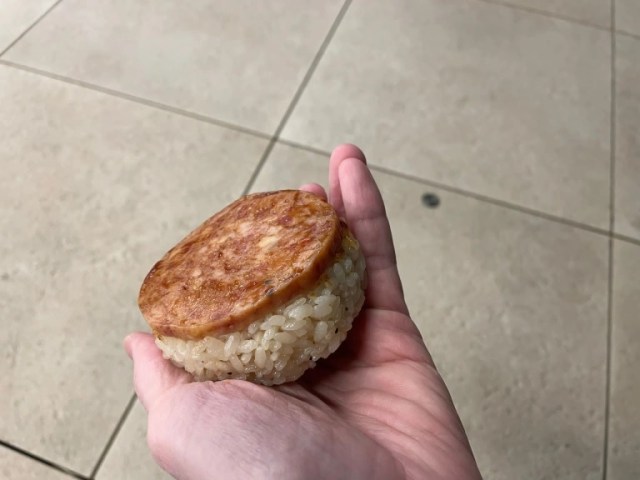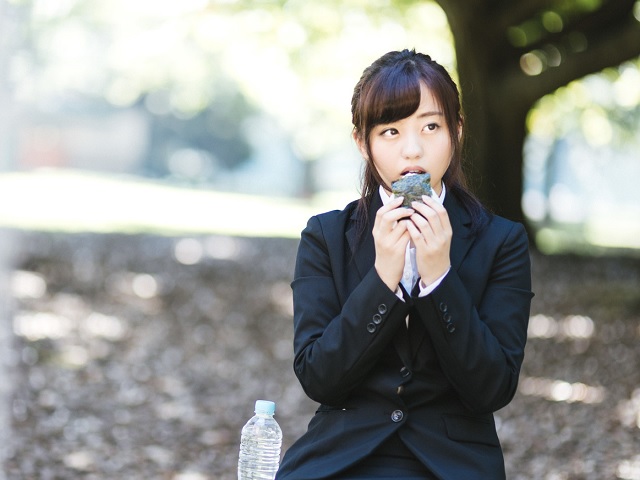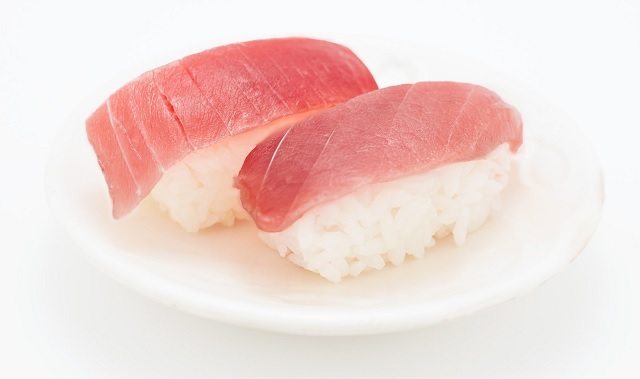
We call them “rice balls” in English, but the real-meaning of “onigiri” is something a lot of Japanese people don’t find appetizing.
In English, we usually call the food known as onigiri in Japanese “rice balls.” But should you have the pleasure of becoming gastronomically acquainted with onigiri, you’ll quickly discover that most of them aren’t ball-shaped. For example, triangular onigiri, like these ones, are extremely common in stores.
Even when onigiri are rounded, they’re more like thick discs than truly spherical balls.
That’s because the word onigiri doesn’t actually mean “rice ball.” It comes from the word nigiru, meaning to squeeze or press, and refers to the traditional way you make onigiri, by pressing the grains of rice together with your hands, with whatever filling you’re using placed at the center or the topping put on top after the onigiri has been formed. Linguistically, onigiri can be whatever shape you want them to be.
But remember how we said pressing the rice by hand is the traditional way to make onigiri? That’s because in the modern era of mass-produced onigiri, they’re often made by machine, and as machine-made onigiri become more and more common, part of the Japanese population has gotten squeamish about eating the pressed-by-hand variety.
Japanese variety program Abema Prime recently conducted a survey asking “Can you eat onigiri that someone else made by hand?”, and of the 50,000 respondents, only 46 percent said they were comfortable consuming bare hand-pressed onigiri.
An additional 42 percent said they were OK eating hand-pressed onigiri on the condition that a layer of plastic wrap had been placed between the rice and the maker’s hands. 10 percent, though said that even that isn’t good enough, and that they’re unwilling to eat hand-pressed onigiri entirely.
▼ The final two percent responded with “other,” but it’s unclear exactly what that means.
So why the strongly negative reaction to bare hand-made onigiri? A few theories spring quickly to mind. Probably the biggest hurdle is that onigiri is pressed after all the ingredients have been cooked. It’s one thing if a chef picks up a piece of meat with an ungloved hand and tosses it into a frying pan before it’s cooked and plated with a spatula. There’s no more heat being applied to that onigiri after it’s formed, though, so effectively someone is grabbing and squeezing your food, then giving it to you to pop into your mouth.
The increasing availability of onigiri at convenience stores is probably another contributing factor. Convenience store onigiri have become the majority of the onigiri many people eat, and since they’re machine-pressed, the concept of eating hand-pressed onigiri, let alone bare hand-pressed onigiri, is becoming increasingly removed from many people’s daily lives.
Along with machine-pressed chain store-bought onigiri becoming so prevalent, another factor to consider is that onigiri aren’t particularly common on restaurant menus. That leaves small, independent takeout shops and home kitchens as the two places you’re most likely to encounter pressed-by-hand onigiri, and in the case of home kitchens, you get into the question of how clean other people keep their homes and non-professional food handler hands, and the answer might not be as clean as you’d like.
Interestingly, pressed-by-hand nigiri sushi (which comes from the same nigiru as onigiri), the most common kind of sushi in which the fish or other topping is placed on a block of rice, doesn’t seem to trigger the same sort of negative reaction. Just like with onigiri, the rice in mass-produced nigiri sushi, such as at inexpensive revolving sushi restaurants or shops, is machine pressed, but at more expensive restaurants the rice is pressed by hand, with plastic wrap or gloves rarely used. Maybe the greater acceptance of bare hand-pressed nigiri sushi has something to do with the high-class image of sushi and sushi chefs.
In any case, though, it’s probably best to keep your reaction expectations modest if you offer someone an onigiri while telling them “I made it myself!”
Source: Sponichi Annex via Yahoo! Japan News via Otakomu
Top image: Pakutaso
Insert images: SoraNews24, Pakutaso (1, 2)
● Want to hear about SoraNews24’s latest articles as soon as they’re published? Follow us on Facebook and Twitter!





 Is it gross to eat sushi that the chef pressed with his bare hands?【Survey】
Is it gross to eat sushi that the chef pressed with his bare hands?【Survey】 The surprising semi-secret ingredient in many Japanese convenience store rice balls: oil
The surprising semi-secret ingredient in many Japanese convenience store rice balls: oil Rice balls that can last for 100 days at room temperature? Kyoto company makes high-protein onigiri
Rice balls that can last for 100 days at room temperature? Kyoto company makes high-protein onigiri Onikun: Epic onigiri so big they’re half demon, half rice ball
Onikun: Epic onigiri so big they’re half demon, half rice ball Okinawan soul fool Pork Tamago Onigiri sold not at a five-star restaurant, but at an airport
Okinawan soul fool Pork Tamago Onigiri sold not at a five-star restaurant, but at an airport Demon Slayer: Kimetsu no Yaiba gets new roller coaster attractions and food at Universal Studios Japan
Demon Slayer: Kimetsu no Yaiba gets new roller coaster attractions and food at Universal Studios Japan How to order snacks on a Shinkansen bullet train in Japan
How to order snacks on a Shinkansen bullet train in Japan Nintendo history you can feel – Super NES, N64, and GameCube controllers become capsule toys
Nintendo history you can feel – Super NES, N64, and GameCube controllers become capsule toys New samurai glasses are Japan’s latest weird must-have souvenir
New samurai glasses are Japan’s latest weird must-have souvenir McDonald’s adds new watermelon frappe and fruity macaron to its menu in Japan
McDonald’s adds new watermelon frappe and fruity macaron to its menu in Japan Hello, cosmetics! Clinique teams up with Hello Kitty this summer for first-time collaboration
Hello, cosmetics! Clinique teams up with Hello Kitty this summer for first-time collaboration Japanese man assaults wife after learning she trolled his YouTube videos for six months
Japanese man assaults wife after learning she trolled his YouTube videos for six months High-fashion Totoro cuddle purse is like an elegant stroll in the forest【Photos】
High-fashion Totoro cuddle purse is like an elegant stroll in the forest【Photos】 Spirited Away train station and submerged tracks attract Ghibli fans around Japan
Spirited Away train station and submerged tracks attract Ghibli fans around Japan Japan’s new difficult-to-drink-from beer glass protects your liver, but it’s a brutal experience
Japan’s new difficult-to-drink-from beer glass protects your liver, but it’s a brutal experience “The most Delicious Cup Noodle in history” – Japan’s French Cup Noodle wins our heart【Taste test】
“The most Delicious Cup Noodle in history” – Japan’s French Cup Noodle wins our heart【Taste test】 Starbucks releases a cute Frappuccino and Unicorn Cake…but not in Japan
Starbucks releases a cute Frappuccino and Unicorn Cake…but not in Japan Kyoto Tower mascot termination reveals dark side behind cute Japanese characters
Kyoto Tower mascot termination reveals dark side behind cute Japanese characters McDonald’s Japan’s Soft Twist Tower: A phantom ice cream only sold at select branches
McDonald’s Japan’s Soft Twist Tower: A phantom ice cream only sold at select branches Yabai Ramen: What makes this Japanese ramen so dangerous?
Yabai Ramen: What makes this Japanese ramen so dangerous? Finally! Nintendo Japan expands Switch 8-bit controller sales to everybody, Online member or not
Finally! Nintendo Japan expands Switch 8-bit controller sales to everybody, Online member or not Japanese government wants to build luxury resorts in all national parks for foreign tourists
Japanese government wants to build luxury resorts in all national parks for foreign tourists To combat declining birth rate, Japan to begin offering “Breeding Visas” to foreigners
To combat declining birth rate, Japan to begin offering “Breeding Visas” to foreigners 10 things you should buy at 7-Eleven in Japan
10 things you should buy at 7-Eleven in Japan Studio Ghibli releases anime heroine cosplay dresses that are super comfy to wear
Studio Ghibli releases anime heroine cosplay dresses that are super comfy to wear Woman charged for driving suitcase without a license in Osaka
Woman charged for driving suitcase without a license in Osaka Studio Ghibli unveils My Neighbour Totoro miniature house model
Studio Ghibli unveils My Neighbour Totoro miniature house model Kyoto experiencing problems with foreign tourists not paying for bus fares, but not on purpose
Kyoto experiencing problems with foreign tourists not paying for bus fares, but not on purpose Fighting mild hunger with a Japanese soda that turns into jelly in the stomach【Taste test】
Fighting mild hunger with a Japanese soda that turns into jelly in the stomach【Taste test】 Studio Ghibli’s Howl’s Moving Castle tapestry unveiled in Japan for first time
Studio Ghibli’s Howl’s Moving Castle tapestry unveiled in Japan for first time McDonald’s new Happy Meals offer up cute and practical Sanrio lifestyle goods
McDonald’s new Happy Meals offer up cute and practical Sanrio lifestyle goods Sales of Japan’s most convenient train ticket/shopping payment cards suspended indefinitely
Sales of Japan’s most convenient train ticket/shopping payment cards suspended indefinitely Sold-out Studio Ghibli desktop humidifiers are back so Totoro can help you through the dry season
Sold-out Studio Ghibli desktop humidifiers are back so Totoro can help you through the dry season Japanese government to make first change to romanization spelling rules since the 1950s
Japanese government to make first change to romanization spelling rules since the 1950s Foreigner’s request for help in Tokyo makes us sad for the state of society
Foreigner’s request for help in Tokyo makes us sad for the state of society Ghibli founders Toshio Suzuki and Hayao Miyazaki contribute to Japanese whisky Totoro label design
Ghibli founders Toshio Suzuki and Hayao Miyazaki contribute to Japanese whisky Totoro label design Doraemon found buried at sea as scene from 1993 anime becomes real life【Photos】
Doraemon found buried at sea as scene from 1993 anime becomes real life【Photos】 Tokyo’s most famous Starbucks is closed
Tokyo’s most famous Starbucks is closed Princesses, fruits, and blacksmiths: Study reveals the 30 most unusual family names in Japan
Princesses, fruits, and blacksmiths: Study reveals the 30 most unusual family names in Japan Awesome rice ball making machine promises perfectly pressed onigiri in just 30 seconds【Video】
Awesome rice ball making machine promises perfectly pressed onigiri in just 30 seconds【Video】 Onigiri good enough to get off the train for: We tried the food at Bongo and it was amazing!
Onigiri good enough to get off the train for: We tried the food at Bongo and it was amazing! Soup curry and onigiri for breakfast at a super tasty semi-secret spot in Tokyo’s Shinjuku
Soup curry and onigiri for breakfast at a super tasty semi-secret spot in Tokyo’s Shinjuku Shinagawa Station sells unappetizing fish butt onigiri, netizens nauseated
Shinagawa Station sells unappetizing fish butt onigiri, netizens nauseated The fastest way to open an onigiri will only take one second 【Video】
The fastest way to open an onigiri will only take one second 【Video】 Haneda Airport’s new rice ball stand — Sister shop Tokyo’s best out-of-the-way onigiri spot
Haneda Airport’s new rice ball stand — Sister shop Tokyo’s best out-of-the-way onigiri spot The Big Bomb Onigiri Japanese rice ball helps us conquer mountain race but conquers us in the end
The Big Bomb Onigiri Japanese rice ball helps us conquer mountain race but conquers us in the end Beyond rice balls: How to make an edible onigiri rice cat【Video】
Beyond rice balls: How to make an edible onigiri rice cat【Video】 Japan’s new hyper-realistic food model is specifically designed to get your coworkers to shut up
Japan’s new hyper-realistic food model is specifically designed to get your coworkers to shut up Taste-testing the Attack on Titan rice ball that “shouldn’t be on sale”【Taste test】
Taste-testing the Attack on Titan rice ball that “shouldn’t be on sale”【Taste test】 Survey ranks convenience store rice balls – salmon, sea-dwelling poultry & plants steal the show
Survey ranks convenience store rice balls – salmon, sea-dwelling poultry & plants steal the show Japan Railways recently revealed ramen-style rice balls in its convenience stores
Japan Railways recently revealed ramen-style rice balls in its convenience stores 7-Eleven Japan to double the shelf life of their onigiri rice balls
7-Eleven Japan to double the shelf life of their onigiri rice balls Former sushi chef serves onigiri rice balls for breakfast at new morning restaurant in Japan
Former sushi chef serves onigiri rice balls for breakfast at new morning restaurant in Japan Eating a rice ball? You could feed five hungry kids just by sharing a photo for charity campaign
Eating a rice ball? You could feed five hungry kids just by sharing a photo for charity campaign
Leave a Reply